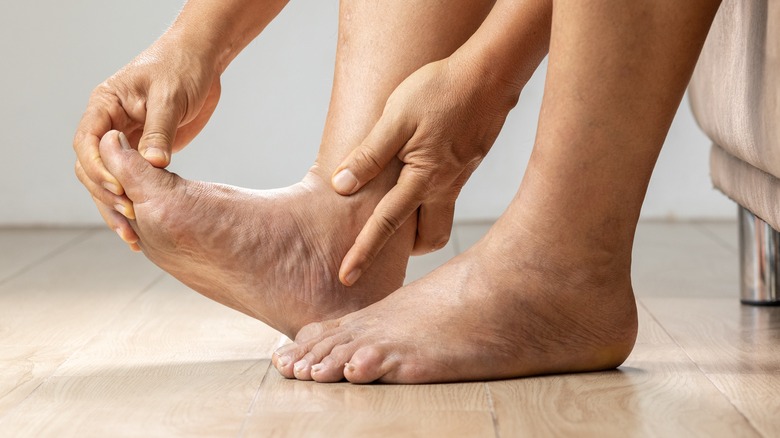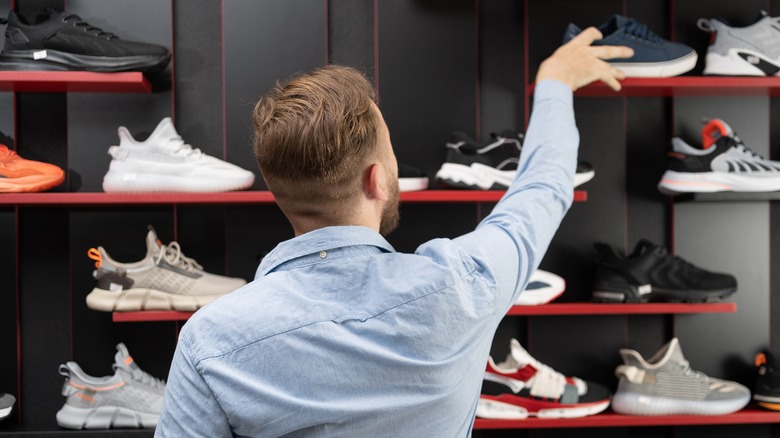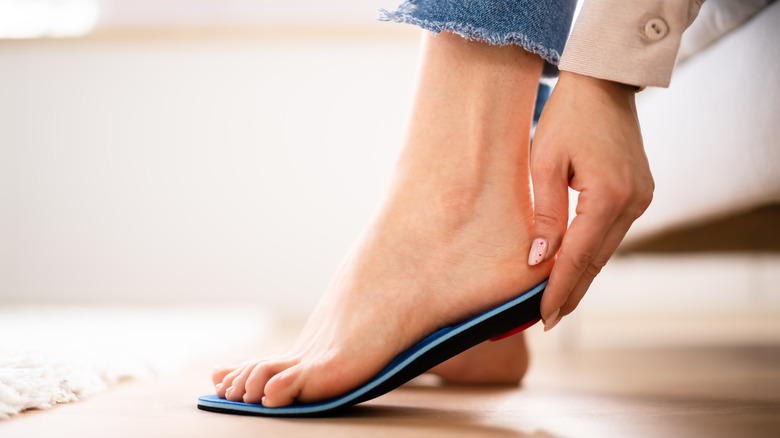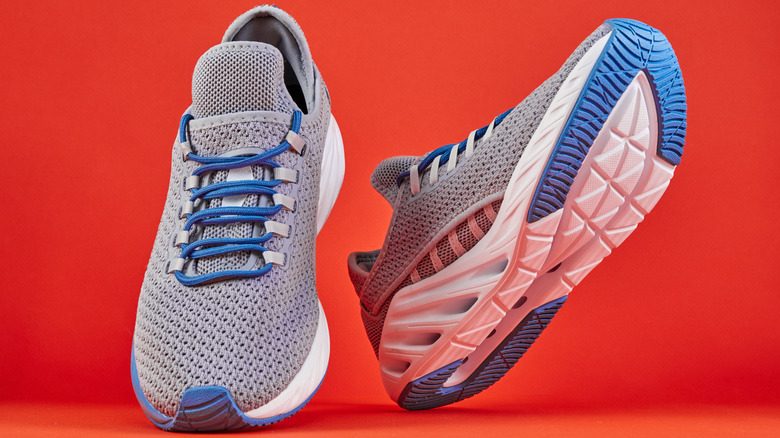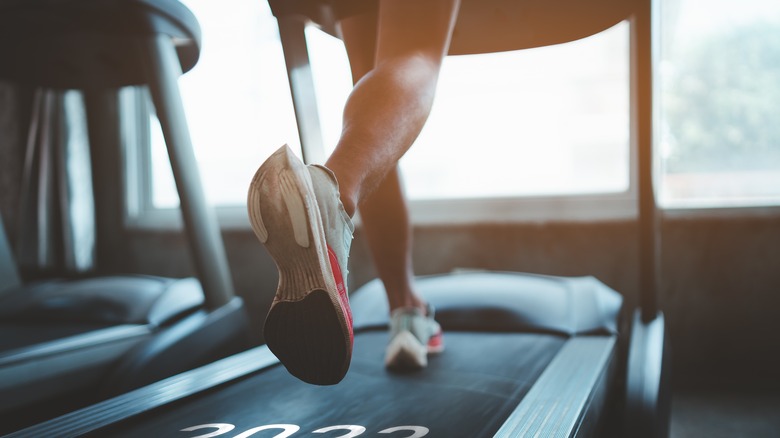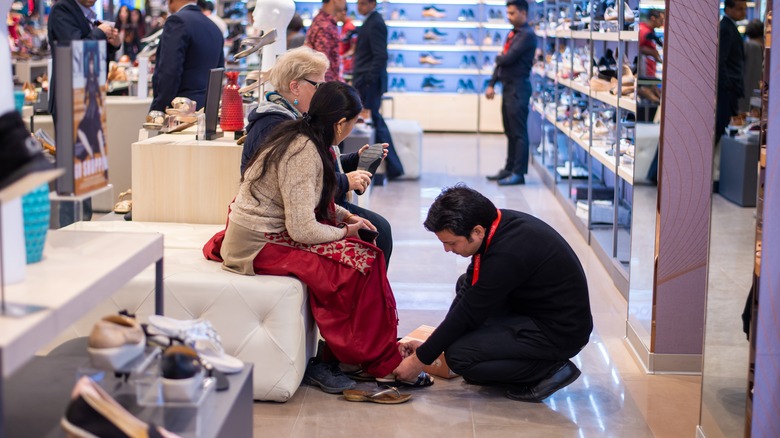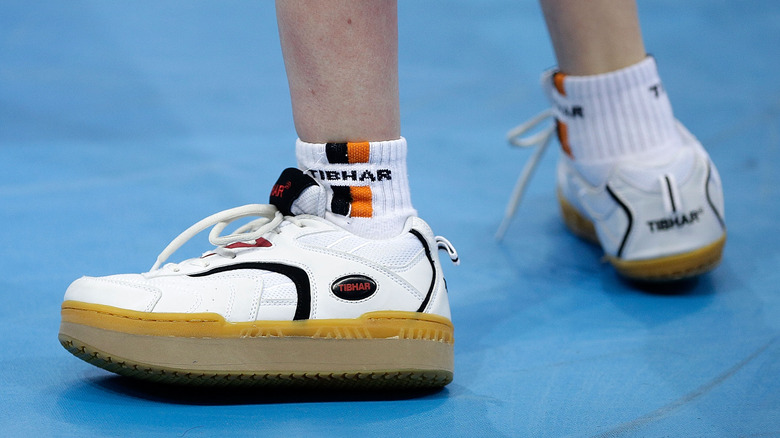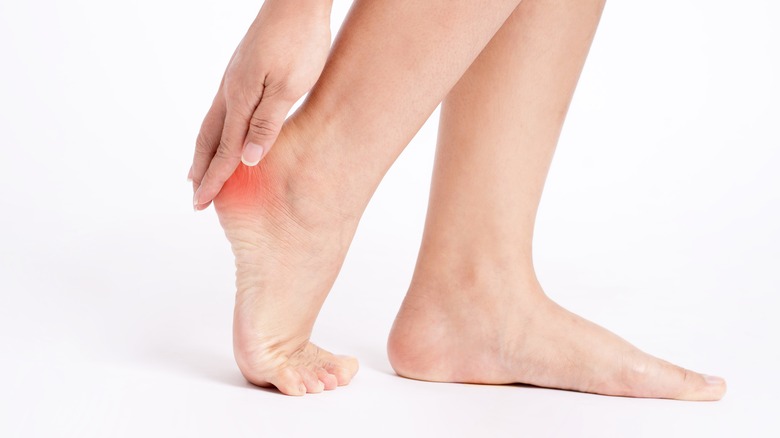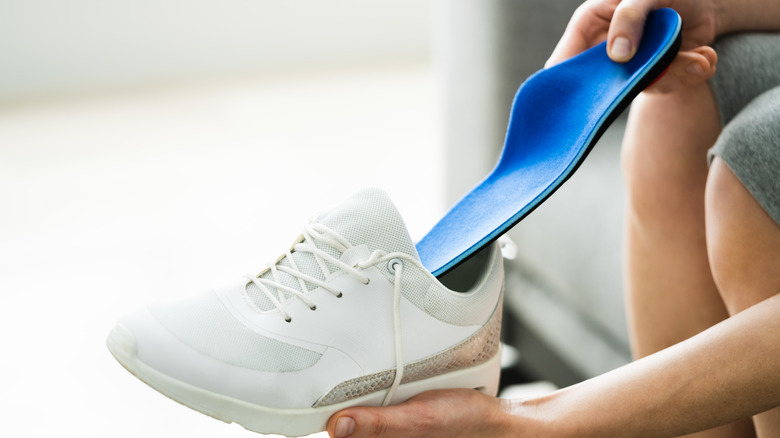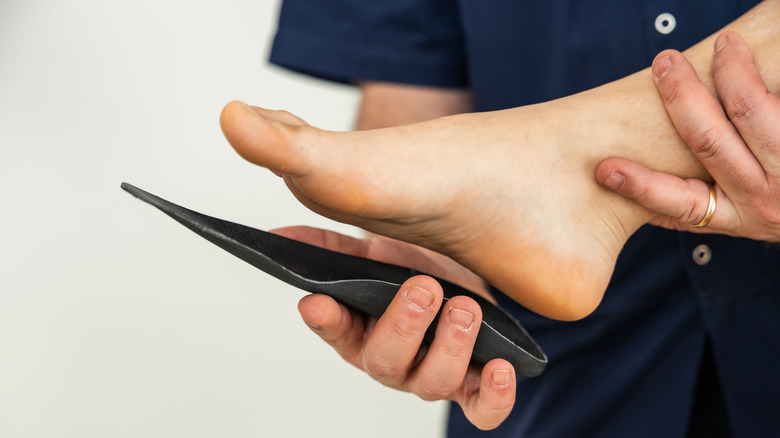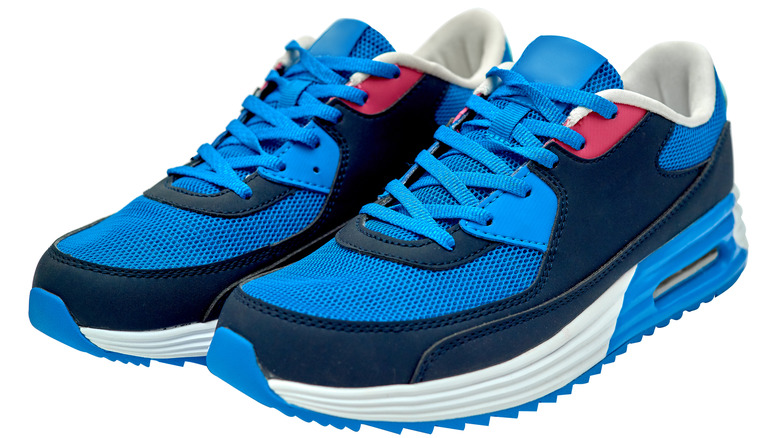12 Tips On Buying Plantar Fasciitis-Friendly Shoes
If your first step out of bed each morning hurts like crazy — or you regularly experience a throbbing pain in the sole of your foot just in front of your heel — you're not alone. Your pain is caused by plantar fasciitis, or scarring of the long ligament (the plantar fascia) connecting your heel bone to the base of your toes. A number of factors can potentially trigger it, including aging (which stiffens the plantar fascia), weight gain, and activities that put repetitive stress on the feet, such as running or prolonged standing or walking.
While painful, plantar fasciitis is easily treatable with a combination of rest, stretches, and proper support for your feet. This means choosing the right shoes is critical if you're recovering from plantar fasciitis. Indeed, walking barefoot can aggravate the condition by causing additional stretching of your already stressed plantar fascia. But if you want shoes that will give your feet the protection they need to heal, not just any shoe will do. Here are some strategies for ensuring you get comfy shoes that will support your feet as they recover.
Measure both feet before trying on shoes
To keep your feet from feeling strained, it's important to get shoes that fit properly. They should neither be so loose that your feet slip around inside of them, nor so tight that your feet feel pinched. This is good advice for everyone, but especially important if you have plantar fasciitis, since your feet need the support that properly fitting shoes can offer.
And even if you've been buying shoes of the same size for years, you should take the time to get both feet measured each time you shop for shoes. There are a couple of reasons to do this: First, our feet can grow bigger or wider as we age, so your shoe size might have changed since the last time you shopped. Second, your feet may be slightly different sizes (and this isn't as rare or as weird as you think). For the same reasons, you should measure the width of your feet as well — a shoe in medium width may feel dramatically different on your feet than the same-size wide or narrow shoe.
But while knowing your correct shoe size (or sizes) matters, trust your feet, not the size label on the shoe, to tell you if you've got a good fit. Different manufacturers may size their shoes slightly differently, so you may need a bigger or smaller size to feel comfortable.
If you wear orthotics, bring them along when shoe-shopping
If you're already being treated for plantar fasciitis, your doctor may have asked you to wear orthotics — either custom fitted or off-the-shelf — to support your arches and alleviate stress on your plantar fascia. These orthotics will also provide arch support and help distribute your weight evenly over your feet as you walk to improve balance and stability.
So if orthotics are part of your treatment, definitely bring them along when shopping for shoes. Since you'll be wearing them in whatever shoes you purchase, you'll want to be sure they fit into the shoes you try and feel comfortable. Shoes that are appropriate for you will allow your orthotics to fit in snugly while still leaving enough room for your feet to fit comfortably. In some cases, orthotics will only fit (or feel comfortable) if the shoes' existing insoles are removed, so check the shoes you're considering to see if this is an option.
Go shoe-shopping at the end of the day
Not only do our feet change sizes as we age, they can also change over the course of any given day. So if you find your shoes starting to feel tight late in the afternoon, you're not imagining things.
If you spend a lot of time sitting during the day, fluid can accumulate in your feet, causing them to swell slightly. This is normal and nothing to worry about, unless the swelling is extreme or varies between feet. These cnditions can indicate circulatory problems, inflections, or other issues that need to be addressed.
Normal foot swelling, however, is also something to bear in mind when shopping for shoes. To ensure you buy shoes that feel as comfortable at 6 p.m. as at 6 a.m., plan to do your shoe shopping late in the day. Shoes that fit well then should work for the rest of the day as well, and you'll be spared not only any extra foot strain that can aggravate your plantar fasciitis, but also the risk of blisters and callouses.
Look for shoes that offer solid support
While the right shoes can't singlehandedly cure plantar fasciitis, they can keep it from getting any worse. Because plantar fasciitis is aggravated when the injured plantar fasciia is stretched, a good shoe can help by preventing or at least minimizing extra stretching or foot strain. Good shoes for those experiencing plantar fasciitis should thus offer solid support for your foot. They should have soles thick enough to protect your feet from impact with hard floor surfaces, along with insoles that offer adequate arch support without being too hard or rigid.
Good shoes for plantar fasciitis need to have a few other structural features as well. Ideally, they should bend at the toes, but not in the middle. They should also be stiff enough in the middle to resist being twisted (so soft, slipper-like shoes or flip-flops are probably not a good choice for you). The heel counter (the rigid piece that runs down the back end of the shoe) should likewise be stiff. Taken together, these features will help keep your feet stable as you walk or run, thus minimizing strain.
If you're a runner, know your running mechanics
Dedicated recreational runners know that while running can be both physically and emotionally rewarding, overdoing it can easily lead to injury. And because repeated foot stress is a cause of plantar fasciitis, runners are no strangers to the ailment. It's generally safe to continue running if your pain is mild, but be smart about it. Warm up carefully before running, stretch thoroughly afterwards, and take a break if your pain gets worse. And, of course, make sure your shoes are giving you the support you need.
Additionally, bear in mind that the right shoe for another runner may not be the best choice for you: Your foot shape and natural running gait are determining factors in how much support and what kind of support you will need for a pain-free run. For instance, if you tend to overpronate (that is, roll your feet more than about 15 degrees inward when running, thus pushing off on your big toe), you might find using more arch support can help alleviate any pain. Similarly, those with flat feet would be better off opting for motion-control or stability running shoes rather than neutral, cushioning ones. Even with this knowledge, however, don't focus on labels to tell you if a shoe is right — try it on and move around in it to ensure it's giving you the support you need.
Seek out shoe stores with knowledgeable fitters
It's easy for anyone to become overwhelmed with decision paralysis when shopping for shoes. But when you have plantar fasciitis and are struggling to find shoes that are both attractive and comfortable, making the right decisions is even harder. After all, if you're busy, tired, and just want something nice and comfy to wear, it's tempting to settle for the first remotely attractive pair that sort-of fits.
This would be a mistake — contrary to popular belief, you can't really break in or stretch shoes to make them fit perfectly. To ensure you get shoes that will work for you without a lot of time-wasting guesswork, seek out a shoe store with a trained staff of fitters. Professional shoe fitters understand different foot conditions (such as plantar fasciitis) and the types of shoes that can address them. They can also help you identify the types of shoe shapes and materials that will be most comfortable for you. In addition, they can also help you make better choices based on your lifestyle — for example, knowing if you run or spend a lot of time on your feet will inform their recommendations.
Look for shoes that offer good cushioning
Long hours on hard surfaces can cause or worsen plantar fasciitis. But for most of us, staying off our feet all day or limiting our movements to soft surfaces isn't a workable option. For this reason, it's important to choose shoes that offer a protective cushion between your feet and the ground. Well-cushioned shoes will absorb some of the impact from walking around, thus alleviating pain and strain on your feet so you can move around comfortably. Thin or rigid soles, on the other hand, will be far less effective for protecting your feet from hard surfaces, and may be painful to wear.
One way you can protect your feet is to seek out shoes with thick, soft, but solid soles, such as those found in running and walking shoes and some sneakers. Other good choices are shoes with soft, supportive insoles, which will do much of the same work of serving as shock absorbers for your feet. (But be careful: Shoes that are too soft and squishy won't provide the stability and support your feet need.) If you find shoes you like but find their insoles too hard, thin, or insufficiently supportive, see if you can remove them. If so, you can switch them out for good-fitting orthotics that will offer the needed cushioning and support.
Shoes that hug the heel will help keep your foot stable
Because plantar fasciitis involves inflammation or scarring of a tendon directly attached to the heel, if you're experiencing the condition, you'll want to choose shoes that minimize excess movement of the affected heel — and thus minimize the chance of unneeded stretching and additional stress on the injured plantar fascia.
Thus, you should look for shoes will a heel counter, a curved, rigid piece running down the back end of the shoe. Heel counters both help shoes keep their shape and keep your heels from slipping as you move, thus protecting the inflamed area by your heel. They also help reduce overpronation, or excessive inward rotation of your foot, another cause of foot pain.
You should also seek out shoes with deep heel cups, which will cradle your heels, holding them in place and keeping them stable as you walk. Finally, shoes with a broad heel base will better absorb shock, reducing pressure on your injured heel.
Removable soles will allow you to use inserts and orthotics more easily
Doctors often recommend orthotics such as custom insoles or heel cups to manage plantar fasciitis – by providing arch support and/or added stability to your feet, they help you minimize stress to the bottoms of your feet. And while some shoes, such as running shoes, have their own built-in arch and heel support, these might not offer enough support to keep you fully comfortable. Thus if you use orthotics, you'll want to ensure they'll fit comfortably into whatever shoes you buy.
In many cases, just slipping your orthotics into the shoe over the existing insole will be a non-starter. You might find there's not enough room in the shoe to accommodate them, or if there is, there might not be enough room for your feet. So when shopping for shoes, you should not only bring your orthotics along for fitting purposes, but also check to see if the shoes you're considering have removeable insoles. If they do, pull them out and insert your orthotics before trying them on to see if you've got a good fit.
Strong arch support is a must
If you have plantar fasciitis — especially if you don't wear custom orthotics — it's essential that you seek out shoes that offer good arch support. Such support will help distribute your weight over your whole foot as you walk, which will both reduce pressure on your plantar fascia as well as on joints in your hips, knees, and ankles.
It's important to recognize, however, that good arch support isn't the same for everybody. Those with flat feet or high arches, both common among those with plantar fasciitis, will have very different requirements for arch support. Thus, it's important that you get your feet measured by an experienced fitter who knows how to check for arch support needs or consult a podiatrist for recommendations. But whether your arches are flat or high, you'll feel a lot better if you give them the right support. A study of 101 people with plantar fasciitis found that those who regularly wore shoes without strong arch support reported greater levels of pain than those who opted for more supportive shoes (via the Journal of Family Medicine and Primary Care).
A slightly elevated heel will help alleviate heel pressure
You probably won't be able to avoid walking around if you have plantar fasciitis, but the right shoes can help make whatever walking you do as safe and comfortable as possible. Your basic aim in shopping for shoes is to seek out those that will protect your feet and keep your condition from worsening by preventing any unnecessary stretching of or stress to your plantar fascia. Arch and heel support help by keeping the bottom of the foot stable as you move. Heel height is another factor that can add to or detract from your comfort.
High heels are thought to be a contributing factor to plantar fasciitis because wearing them regularly can shorten the plantar fascia, making it more vulnerable to tearing. Completely flat shoes were also found to contribute to heel pain and worsening of the condition (via the Journal of Family Medicine and Primary Care). However, a slightly elevated heel (between .1 and 1.5 inches) was found to reduce pain by reducing pressure on the heel (per GoodRx). You can find shoes in a range of styles, from running shoes to sandals, with heels within this range.
Be picky when shopping for shoes
There's no getting around it: Shopping for shoes when you're experiencing plantar fasciitis can be a bit of a slog. While there is plenty of medically accepted guidance for important features to look for in a shoe, there's no single shoe or brand of shoe that will be a great fit for everyone. The only way you can find the shoes that are most comfortable for you is to try on a bunch of them to see what works — just because a friend raved about a shoe doesn't mean it will be a good choice for you.
So do your homework. Don't be afraid to ask questions when you shop, and take your time to make sure the shoes you're trying really feel comfortable when you walk. Try on a size bigger or smaller if the fit feels off. And if something really feels off — such as an off-kilter insole or unusual pressure when you walk — give it a hard pass. Defective shoes have been found to trigger plantar fasciitis in rare cases (via the Journal of Orthopaedic & Sports Physical Therapy), and you certainly don't want to make your problem worse. And if you can, invest in good-quality shoes. Inexpensive shoes can break down within months, potentially exposing your feet to more stress.

